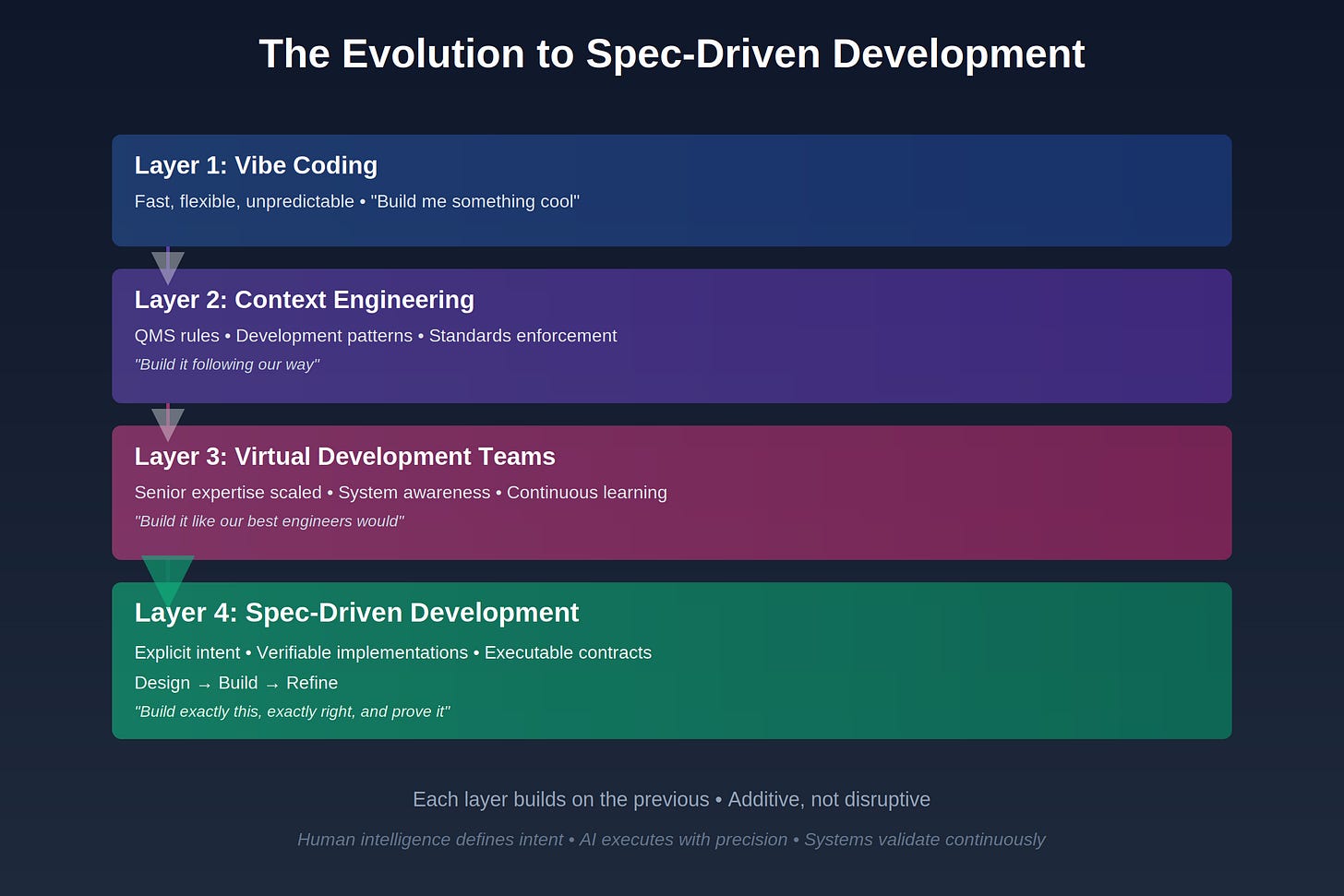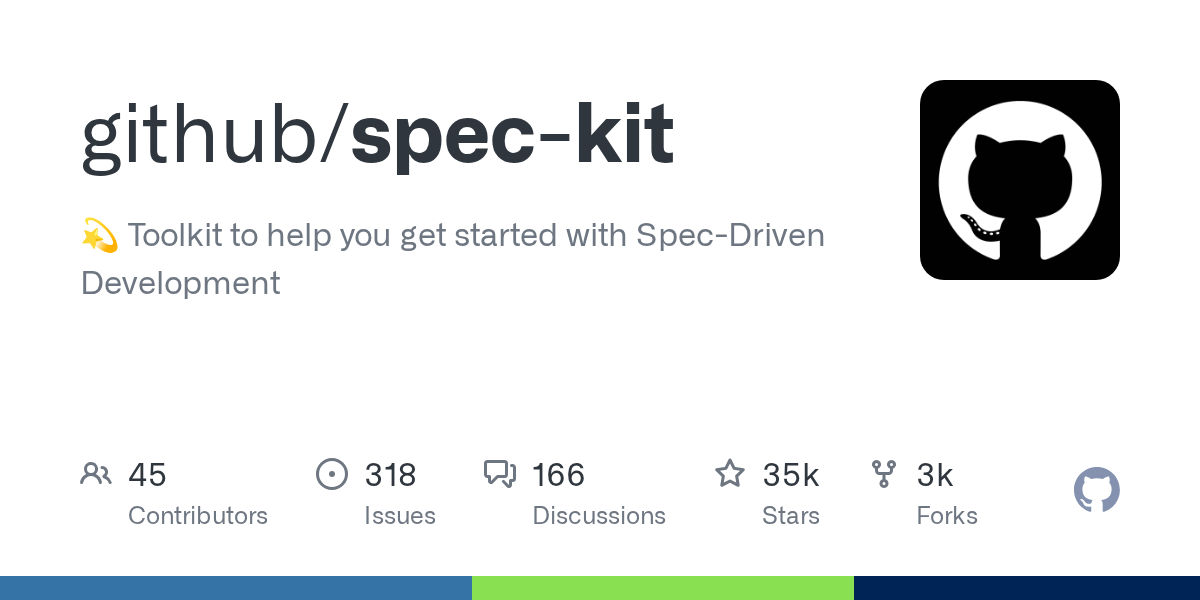From Context Engineering to Spec-Driven Development: The Inevitable Next Step
Turning Virtual Development Teams into Specification Machines
I’ve written previously about vibe coding through context engineering to virtual development teams. Each step represented an evolution in how we leverage AI for software development. But here’s what’s becoming clear: we’re not done evolving.
You’ve encoded your QMS into your AI coding environment. You’ve built development modes that embody your senior engineers’ expertise. You’ve connected your AI to live system data that provides situational awareness. You’ve established feedback patterns that capture learnings and evolve your system.
And it’s working. Your code quality is up. Your team is more productive. Your virtual development team is scaling expertise across the organization.
Now imagine taking everything you’ve built and adding an additional layer: explicit specifications that serve as the contract between intent and implementation. Not because context engineering isn’t enough, but because specifications unlock capabilities that context engineering alone can’t provide.
This is where Spec-Driven Development (SDD) enters—not as a replacement, but as the natural next evolution of the process.
Context Engineering: The Foundation We’re Building On
Let’s be clear: context engineering is powerful and remains essential. Your custom instructions, development modes, and system integrations aren’t going anywhere. They’re the infrastructure that makes spec-driven development excel.
Context engineering tells your AI how to build things. It encodes patterns, enforces standards, and embodies expertise. It’s the difference between an AI that generates prototype code and one that generates production code that looks like your senior engineer wrote it.
But here’s what context engineering doesn’t explicitly capture: what you’re building and why. Your QMS says “always use circuit breakers for external calls,” but it doesn’t say “this service integrates with three payment providers, each with different failure modes, and here’s our strategy for handling them.”
Your development modes know architectural patterns, but they don’t know the specific architectural decisions for this particular service. Your system integrations provide awareness, but they don’t capture the intent behind the system.
That’s not a limitation—it’s an opportunity for the next layer.
Specifications: The Missing Piece
Specifications add explicit intent to your context engineering infrastructure. They answer questions that context engineering leaves implicit:
What are we building?
Why are we building it this way?
What quality attributes must it have?
How do we verify it’s correct?
Think of it as the relationship between a programming language and a program. Your context engineering defines the language—syntax, idioms, patterns. Specifications write the program—what this particular system does and why it matters.
Together, they create something more powerful than either alone: a development system where both the “how” and the “what” are explicit, executable, and verifiable.
Your virtual development team doesn’t just know how to write good code—it knows exactly what code to write and can prove it’s correct.
The Synergy: Context Engineering + Specifications
Here’s where things get interesting. When you combine context engineering with specifications, each amplifies the other.
Your development modes become specification-aware. Instead of encoding general patterns, they learn to recognize specification patterns and apply the right architectural decisions automatically. Point a mode at a specification, and it knows not just how to write microservices, but how to write this specific microservice.
Your system integrations gain validation superpowers. They don’t just provide system awareness—they validate that the running system matches its specification. Real-time drift detection becomes possible.
Your feedback patterns evolve faster. Instead of just capturing “this code review had issues,” you capture “the implementation deviated from the spec here.” The feedback is more structured and actionable.
Your virtual development team becomes specification executors. They don’t just help developers write code—they transform specifications into validated implementations.
From Vibe Coding to Specification Excellence: The Complete Stack
Let’s trace the complete evolution, where each layer builds on the previous:
Layer 1 - Vibe Coding: AI generates code based on prompts and probability. Fast, flexible, unpredictable, prototype code.
Layer 2 - Context Engineering: AI generates code following your standards and patterns. Consistent, maintainable, scalable.
Layer 3 - Virtual Teams: AI embodies senior expertise across all development. Your best practices are available everywhere, continuously evolving.
Layer 4 - Spec-Driven: AI implements explicit specifications using the standards, patterns, and expertise from layers 2 and 3. Intent is clear, implementation is verifiable, quality is provable.
Notice that we’re not replacing layers—we’re stacking them. Vibe coding is still perfect for prototyping. Context engineering still enforces your QMS. Virtual teams still scale expertise. Specifications add the final piece: explicit, verifiable intent.
The Three Phases: Design, Build, Refine
Spec-driven development with AI augmentation operates in three distinct phases, each leveraging your existing context engineering infrastructure:
Design Phase: Specification Creation
This is where your senior engineers shine—but now your virtual development team participates actively.
Instead of starting from scratch, engineers can ask AI to draft specifications by:
Analyzing existing implementations via system integrations
Suggesting patterns based on development modes
Identifying gaps by comparing similar services
Proposing quality attributes from your QMS
A specification might look like:
# Payment Service Specification v2.1
## Purpose
Process customer payments through multiple providers while maintaining
PCI compliance and providing audit trails for financial reconciliation.
## Architectural Decisions
- **Pattern**: Adapter pattern for provider integration
*Rationale*: Providers change, business logic should not
- **Data Flow**: Command Query Responsibility Segregation (CQRS)
*Rationale*: Read patterns differ from write patterns; separate for scale
- **Error Handling**: Circuit breaker per provider
*Rationale*: Provider failures should not cascade
## API Contract
[Executable API specifications with examples]
## Quality Attributes
- Latency: p95 < 200ms for authorization requests
- Unit Test Coverage: 100%
- Availability: 99.95% excluding provider outages
- Security: PCI DSS Level 1 compliant
- Auditability: Every transaction fully traceable
## Validation Criteria
[How we know the implementation matches this spec]
Notice how the specification references patterns your context engineering already knows (circuit breakers, CQRS) and quality attributes your QMS already enforces (PCI compliance, audit trails). The specification builds on your context engineering rather than replacing it.
Build Phase: Specification-Driven Generation
This is where your existing infrastructure shines. Your development modes already understand patterns. Your system integrations already provide awareness. Your QMS rules already enforce standards.
Now, instead of developers describing what they want, they point the AI at specifications: “Implement this spec using our microservice patterns.”
The AI generates:
Implementation code following your QMS (context engineering)
Using the patterns from your development modes (context engineering)
Aware of your existing systems (system integrations)
Fulfilling the specific requirements in the specification (new layer)
The magic is that developers review specification compliance rather than code quality. Your context engineering already handled quality. The review becomes: “Does this implementation match what the spec says we’re building?”
Refine Phase: Closing the Loop
Your feedback patterns already capture learnings and evolve your system. Specifications add structure to that feedback loop.
When reality deviates from expectations, you now have a clear question: Was the specification incomplete, or was the implementation incorrect?
Spec was unclear → Update specification, regenerate implementation
Implementation took shortcuts → Fix implementation against spec
Spec was wrong → Update spec based on learning, propagate changes
Over time, your specifications become increasingly accurate, and your virtual development team learns which specification patterns lead to successful implementations.
The key insight: Your context engineering infrastructure already provides the learning mechanism. Specifications just make the learning more structured and explicit.
When to Add the Specification Layer
You don’t need specifications for everything. Your existing context engineering might be sufficient for some projects. Consider adding the specification layer when:
Architectural Decisions Matter: The system has significant architectural choices that need documentation and validation. Simple CRUD apps might not need specs; complex distributed systems do.
Multiple Developers Are Involved: Specifications provide shared understanding that keeps distributed or mixed-experience teams aligned. Solo projects might not need them.
Long-term Maintenance Is Expected: The codebase will outlive the original developers. Specifications ensure future teams understand not just what the code does, but why.
Compliance Creates Audit Requirements: Regulated industries need to prove what the system does and why. Specifications provide that evidence trail.
Quality Attributes Are Critical: When “ship it and fix bugs later” isn’t acceptable. Specifications let you define and verify non-functional requirements upfront.
AI Agents Are Primary Contributors: When AI isn’t just assisting but generating significant portions of the codebase. Specifications give AI the unambiguous input it needs for production-quality output.
Practical Implementation: Building on What You Have
The beauty of spec-driven development is that you’ve already built most of the infrastructure. You’re adding a layer, not replacing your system.
Start with One High-Value Component: Don’t specify everything. Choose your most complex, critical, or frequently misunderstood component. Write its specification first.
Extend Your Development Modes: Your modes already encode patterns. Enhance them to recognize specification sections and apply the right patterns automatically. A microservice mode learns to read service specs and generate conforming implementations.
Connect Specs to System Integration: Your integrations provide system awareness. Add validation queries that check if running systems match their specifications. This creates continuous verification of spec compliance.
Enhance Your Feedback Workflows: Your feedback loops already capture issues. Structure them to identify spec-implementation mismatches and suggest specification updates based on production learnings.
Version Control Specifications Like Code: Use the same PR review process for spec changes as code changes. When specs change, your virtual team can identify affected implementations automatically.
Make Specs Executable Where Possible: API specifications can use OpenAPI. Database schemas can use migration scripts. Event schemas can use JSON Schema. The more executable your specs, the more your context engineering can validate automatically.
Tools and Ecosystem
While the concepts of spec-driven development predate any specific tool, having the right infrastructure helps.
Tools like GitHub’s spec-kit provide frameworks for managing specifications as code, maintaining traceability between specs and implementations, and validating consistency. Github has a good post on their SDD tool.
The key is treating specifications as first-class artifacts that integrate with your existing context engineering:
Specifications reference patterns defined in your development modes
Development modes recognize specification structures
System integrations validate spec compliance at runtime
Feedback patterns update specs based on learnings
Your AI development environment should understand specifications natively while still leveraging all your context engineering infrastructure.
The Cultural Evolution: Additive, Not Disruptive
Here’s the good news: if your team has already embraced context engineering, adding specifications is a natural next step.
You’ve already accepted that encoding standards makes development better. You’ve already seen that systematic approaches beat ad-hoc ones. You’ve already experienced the value of making implicit knowledge explicit.
Specifications are just the next iteration of that same philosophy: making intent as explicit as you’ve already made standards.
Some developers might resist initially, seeing specs as “too much process.” This is where demonstrating value matters more than mandate:
Show that specs reduce rework by catching misunderstandings early
Demonstrate that spec reviews are faster than code reviews
Prove that onboarding is easier when intent is explicit
Measure that production issues decrease when requirements are clear
The developers who embraced context engineering will likely embrace specifications for the same reasons: they make the work better while making the work easier.
Different Metrics for Different Goals
Your context engineering metrics already track code quality, consistency, and team efficiency. Specifications add new dimensions:
Specification Quality Metrics:
How stable are specifications after initial implementation?
How often do implementations match specs on first generation?
How much specification reuse occurs across projects?
Review Efficiency Metrics:
Time spent on “does this match the spec” vs “is this good code”?
Percentage of review comments about specification gaps vs implementation issues
Speed of confident approval for spec-compliant implementations
Team Alignment Metrics:
How quickly do new developers contribute to spec-driven projects?
How often do different developers interpret requirements differently?
Cross-team consistency in implementations of similar specs
Production Confidence Metrics:
How often does production behavior match specification expectations?
Rate of “it works but we’re not sure why” incidents
Time from implementation to confident deployment
The most revealing metric is specification leverage: how often do specifications get referenced, reused, or serve as inputs to new work? High leverage means your specifications are genuinely valuable, not just documentation theater.
The Future: Layered Intelligence
Once you have specifications working with context engineering and virtual teams, new possibilities emerge:
Specification Composition: Complex systems become compositions of smaller specifications. Your payment service spec references your audit logging spec, security spec, and observability spec. Your context engineering understands these dependencies.
Cross-System Verification: With specifications for services and context engineering that validates them, you can prove that system interactions match both sides’ expectations. Integration becomes verifiable.
Intelligent Evolution: Your feedback patterns identify issues, your virtual team proposes specification updates, your context engineering validates the changes. The system improves itself systematically.
Automated Orchestration: With specifications as machine-readable intent and context engineering that implements them, deployment systems make intelligent decisions about rollouts, testing, and monitoring.
We’re building toward a development system where human intelligence defines what and why, artificial intelligence handles how, and the system continuously validates that reality matches intent.
Where We Are: A More Perfect Stack
Let’s zoom out and see what we’ve built across these three articles:
Foundation - Context Engineering: Encode standards, patterns, and expertise into your AI development environment. Make quality systematic rather than accidental.
Amplification - Virtual Development Teams: Scale expertise across the organization. Make senior engineering judgment available everywhere, continuously learning and evolving.
Direction - Spec-Driven Development: Add explicit intent to guide your virtual teams. Transform “build something good” into “build exactly this, exactly right.”
Together, these create a development system where:
Standards are encoded and enforced (context engineering)
Expertise is scaled and available (virtual teams)
Intent is explicit and verifiable (specifications)
Quality improves continuously (feedback patterns)
Humans focus on what matters (architecture and business logic)
AI handles the mechanics (implementation and validation)
Each layer enhances rather than replaces the previous layers. You’re not choosing between them—you’re stacking capabilities.
Getting Started Tomorrow
If you’ve already implemented context engineering with virtual teams, adding spec-driven development is your natural next step:
Choose One Component: Pick something complex enough to benefit from explicit specification but small enough to learn from
Write Its Specification: Capture architectural decisions, quality attributes, and validation criteria—reference your existing development modes and QMS rules
Enhance Your Development Modes: Teach them to recognize and implement specification patterns
Implement and Validate: Generate the implementation using your enhanced modes, verify it matches the spec
Measure and Learn: Track what works (faster reviews? fewer defects? clearer intent?) and what needs refinement
Expand Gradually: As the model proves valuable, specify more components and deepen the integration
Start small, leverage what you’ve already built, and let results drive adoption.
The Promise: Continuous Evolution
We’re still early in this journey. The tools are maturing. The practices are evolving. The culture is adapting.
But the direction is clear. Each layer we add—context engineering, virtual teams, specifications—makes software development more systematic, more scalable, and more successful.
This isn’t about removing human judgment or creativity. It’s about applying intelligence at the right levels:
Humans define intent, make architectural decisions, solve business problems
AI implements those decisions using encoded expertise and standards
Systems validate that implementations match intentions
Everyone learns continuously from the results
Spec-driven development, powered by context engineering and virtual teams, lets us focus human intelligence where it matters most while letting AI handle the mechanical implementation details with unprecedented consistency and quality.
We’re not replacing developers. We’re building development systems that make everyone more effective.
And we’re just getting started.




